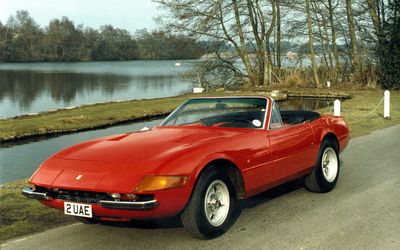









MASTERS OF EUROPE
SCHETTY WINS THE EUROPEAN MOUNTAIN






MASTERS OF EUROPE
Peter Schetty was a young, wealthy Swiss, backed by a family that owned a textile business that wanted to see him run the company with his father. He had a passion for racing though, and showed his talent with a second place in the GT category of the 1966 European Hillclimb Championship, in the GT category.

When he finished his studies with a double degree, he signed on as an official Abarth driver. At 25 years old, in 1967, he finished third in the European Hill Climb Championship. Karl Abarth kept him on through 1968 and he competed in a number of Sportscar races, notching up several wins. However, that great talent scout Enzo Ferrari had already set his sights on the young Swiss and signed him up in advance for the following year. Schetty enjoyed a good reputation among the experts. He was serious, methodical and fast, impressing Paul Frère who had taught him at Hanseat Driving School at the Nürburgring. When Enzo Ferrari called him to Maranello, he was a little excited and nervous, but everything went well. He signed an agreement with the Scuderia to develop the 212 E, racing it in the 1969 European Hill Climb Championship. He also tested the P 312 for the World Sports-Prototypes Championship, with which he also took part in the 1000 km of Monza and the 24 hours of Spa, athough he was unable to reach the finish line due to the mistakes of his teammates. It was a triumphant uphill season, with seven wins out of seven races, which brought victory in the European Championship, ahead of the Abarth of Arturo Merzario. The team consisted of Schetty, Ferrari engineer Marelli, two mechanics and a few spare parts. There was no spare engine: everything was done economically with no room for errors! The Swiss driver won in Spain at Montseny, Rossfeld in Germany, Mont Ventoux in France, the Trento-Bondone in Italy, then again in Germany, in Freiburg, in the other Italian race, Cesana-Sestriere, and Ollon-Villars, on his home mountain. The Ferrari 212 E, chassis number 0862, was designed specifically for the European Hill Climb Championship.
It had a 2-litre, 12-cylinder boxer engine with an output of 300 hp at 11,800 revs per minute, a high range for the time, derived from the Formula 1 engine used in the 1965 World Championship. The car was low and compact, agile on mountain roads. It had very precise aerodynamics and a livery that emphasised its grit: completely red, with no sponsorships, a large rear spoiler and two side flaps on the nose. Schetty also tested the Dino 246 for the Tasman Cup and the 12-cylinder 3.0 litre boxer engine for the F1 1970. The following year he joined the team for the World Championship for Makes clinching some podiums, while the 212 was sold to the private driver Edoardo Lualdi-Gabardi, who won the Italian Mountain Trophy. At the end of 1970, Ferrari proposed that Schetty should stop racing to become team manager and tester. Schetty accepted and for two years, in 1971 and 1972, he coached the team in the World Championship for Makes. Results were poor in 1971 because of too many driver errors, but in 1972, with the 3-litre 312 PB, there were none by anyone: the team won 10 out of 11 races and the world championship. In 1973, Schetty decided it was time to return to the family business and left the world of racing.
